How to Measure For Vertical Blinds
Tips
Use a metal tape measure to ensure accurate measurements
Brackets Sizes Guide
Vertical blinds can be fitted either top fixed, where you screw the blind into the top of the recess or face fixed, where the brackets are screwed facewards into the window frame. The same top fix bracket is used for 89mm/127mm slats widths, however there are different size face fix brackets for 89mm/127mm slat size. Use the information below to determine the bracket allowance depending on the best fitting surface and slat size chosen. This will be referred to as X.
Top Fix
The brackets are fixed into the top of the recess
BRACKET SIZE: 42mm
89mm louvres, bracket allowance: X=70mm
127mm louvres, bracket allowance: X=89mm
This will give a clearance of approximately 25mm between louvre and fitting surface allowing for louvres to rotate freely and for small window handles or obstructions. ( Allowance for any larger handles will be made later.
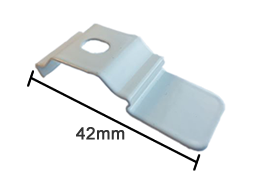
Small Face Fix (only used on 89mm louvres)
The brackets are fixed into the window frame
BRACKET ALLOWANCE: 75mm
This will give a clearance of approximately 25mm between 89mm louvres and fitting surface allowing for louvres to rotate freely and for small window handles or obstructions. ( Allowance for any larger handles will be made later.
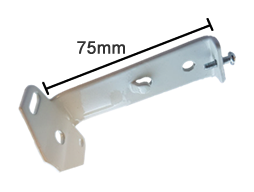
Large Face Fix
The brackets are fixed into the window frame
BRACKET ALLOWANCE: 93mm
This will give a clearance of approximately 49mm on 89mm louvres and 25mm on 127mm louvres between fitting surface allowing for louvres to rotate freely and for small window handles or obstructions. ( Allowance for any larger handles will be made later.
Note down X for the next step.
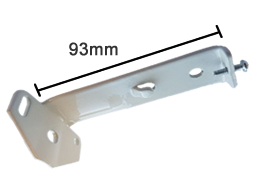
How to Measure Vertical Blinds For Standard Windows
Recess Size
Measure the wall-to-wall width at 3 places and the drop from the top recess to the window sill. Note down the smallest of each of the 3 measurements. Do not make any deductions, we will do this during manufacture. Approximately 10mm from the width to ensure a comfortable fit. You can order in inches, cm, or mm.
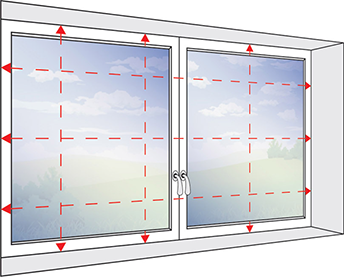
Exact Size
Measure the wall-to-wall width at 3 places and the drop from the top recess to the window sill. Add on 30cm to the width and drop to allow for sufficient overhang. The blind will be made to these exact sizes from the top of the track to the bottom of the fabric. You can order in inches, cm, or mm.
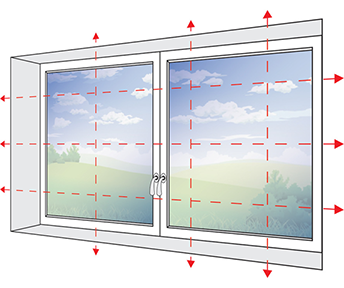
Part Tiled Recess
Measure the full width at the top and middle of the recess then the width between the tiles.
If the difference is less than 25mm as it will be in most cases then use the measurement at the top as there will be enough clearance for the fabric and order as recess size.
If the difference is more than 25mm then use the tiles recess size for the width and order as recess size.
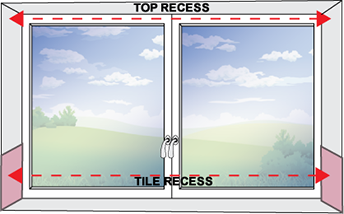
How to Measure Vertical Blinds For Bay Windows
Angled Bay Windows
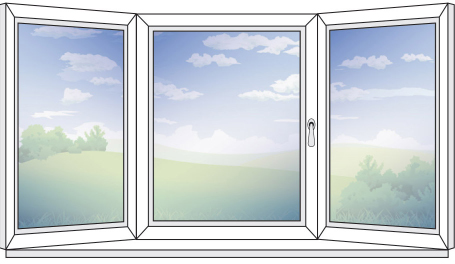
Step 1
Measure the protrusion of the window handle. 25mm or less move on to the next step as this is already allowed for selecting the brackets.
Over 25mm you will need to make an additional allowance. Measure the handle protrusion as shown in the image opposite e.g. 45mm.
Additional Allowance:
45mm window handle - 25mm allowance = 20mm

Step 2
Take an A4 sheet of paper and cut in half. Place the two pieces of paper next to each other and mark a line at measurement X.
e.g. Top fix brackets, 89mm louvres
X = 70mm
e.g. Top fix brackets, 89mm louvres, window handles of 45mm
X = 70mm + 20mm = 90mm

Step 3
1) Place the pieces of paper on the window sill touching the frame and slide together until the two lines meet.
2) Then using a pencil make a mark on the window sill at the point where the corner of the paper meets the frame.
3) Repeat on the other angles around the bay conservatory.

Step 4
Measure the distance between the two pencil marks on each window around the bay as shown on the illustration. This will give you the widths the blinds will need to be.
Drop
Measure from where the top of the bracket is to be fitted, to the window sill. Check the drop all around the bay as it will often differ. DEDUCT 10mm from the smallest drop to allow for some clearance.
Order all blinds as EXACT SIZE.

Drop
Measure from where the top of the bracket is to be fitted, to the window sill. Check the drop all around the bay as it will often differ. DEDUCT 10mm from the smallest drop to allow for some clearance.
Order all blinds as EXACT SIZE.
Box Bay Windows

The first thing to do is decide how you want to fit your blinds. Choose from the options below. Review the summary next to each image for tips on which is best for your window.
Option 1: The most common method of installation
This method is designed to ensure that the two side
blinds butt up against the front blind which is
measured to fill the entire width of the front window.
The allowances for the brackets and the louvre size
chosen will the sizes of the side blinds. East to follow
instructions are on the following page.

Option 2: The most Tricky method of installation
For the confident measurer, this gives a more
professional fit as the blinds meet in the corner but
is dependent on a minimum frame size of 70mm
Measure from the corner of the glass, is the frame
is less than 70mm then go for option 1 to avoid the
blinds not covering the glass properly.

Option 1: The most common method of installation
1) Measure the full width of the front window. Order as RECESS SIZE
2) Measure the full width of each side window separately as they are often different and note the sizes down then deduct X from that size.
e.g. Left hand side window 89mm louvres, top fix brackets, window handles 25mm or less
Top fix brackets, X = 70mm
870mm wide - X (70mm) = 800mm wide
e.g. Left hand side window 89mm louvres, top fix brackets
Top fix brackets: X = 70mm | window handles of 45mm = additional handles allowance of 20mm
870mm wide - x (70mm) - 20mm = 780mm wide
Option 2: The most tricky method of installation
On both corners measure from the corner of the bay to the start of the glass, if either measurement is less than 70mm then we recommend to not use this option and use option 1.
1) Measure the full width of the front window then deduct x and the additional handle allowance twice ifnecessary.
e.g. Front window 89mm louvres, top fix brackets, window handles 25mm or less
Top fix brackets, X = 70mm
2200mm wide - X (70mm) - X (70mm) = 2060mm wide
e.g. Front window 89mm louvres, top fix brackets
Top fix brackets: X = 70mm | window handles of 45mm = additional handles allowance of 20mm
2200mm wide - X (70mm) - 20mm - X (70mm) - 20mm= 2020mm wide
2) Measure the full width of each side window separately as they are often different and note the sizes down
then deduct X from that size.
e.g. Left hand side window 89mm louvres, top fix brackets, window handles 25mm or less
Top fix brackets, X = 70mm
870mm wide - X (70mm) = 800mm wide
e.g. Left hand side window 89mm louvres, top fix brackets, window handles of 45mm
Top fix brackets, X = 70mm
870mm wide - X (70mm) - 20mm = 780mm wide
Drop
Measure from where the top of the bracket is to be fitted to the window sill. Check the drop all around the bay as it will often differ. DEDUCT 10mm from the smallest drop to allow for some clearance.
Order all blinds as EXACT SIZE.
How to Measure Vertical Blinds For Conservatories
Conservatories generally come in two shapes, angled or square so all you need to do is use the same instructions as for bay windows.
Download Instructions
How to measure vertical blinds for normal windows
How to measure vertical blinds for angled bay windows
How to measure vertical blinds for boxed bay windows
How to measure vertical blinds for angled conservatories
How to measure vertical blinds for square conservatories
















































































